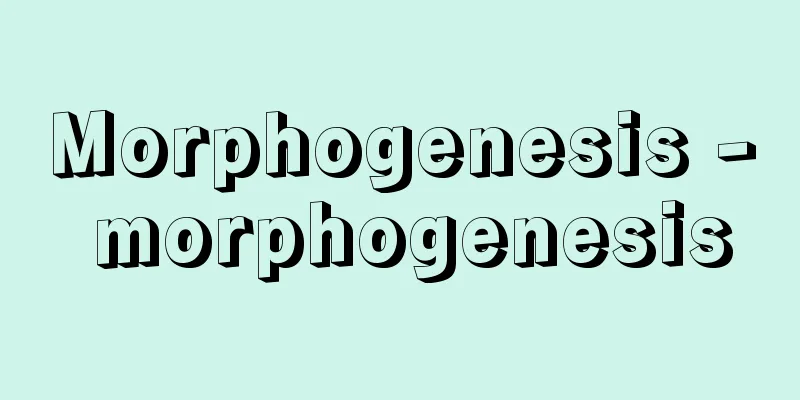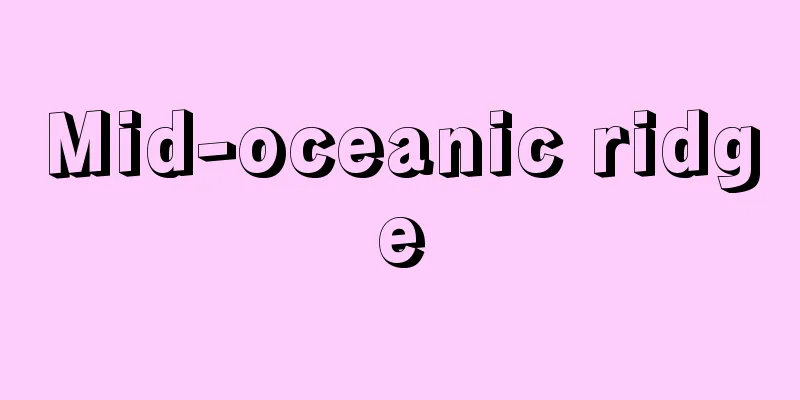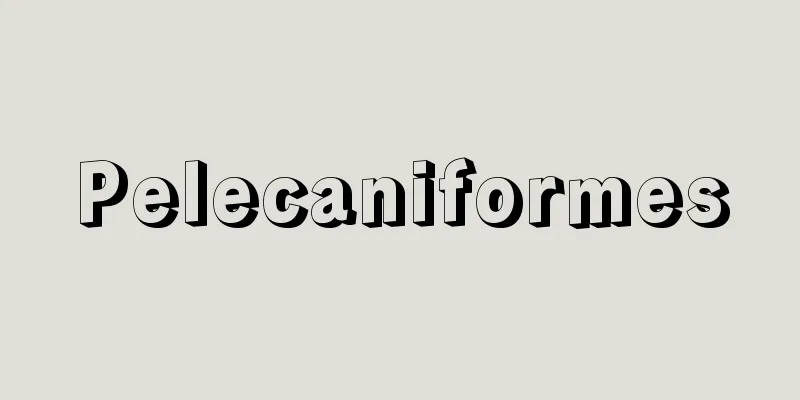Morphogenesis - morphogenesis

|
In the development of an organism, this refers to the process in which the organism's unique shape is formed through the differentiation and growth of new tissues and organs, rather than through a simple aggregation of similar cells. This is also called morphogenesis or morphogenesis. Therefore, the phenomenon in which a fertilized egg develops into an individual can be said to be the sum of the morphogenesis that occurs in various parts of the embryo. During morphogenesis, cells undergo significant movement and migration, as observed in both animals and plants. This is called morphogenetic movement or plastic movement. [Seiichiro Kawashima] animalMorphogenesis is thought to occur when morphological changes in individual cells bring about morphological changes in the entire group of cells that are attached to each other. For example, in the development of echinoderms, a fertilized egg undergoes repeated cell division to transform from a morula to a hollow blastula. Next, it invaginates from the vegetal pole to form the archenteron, entering a stage called a blastula. During gastrulation, fibrous structures form on the inner surface of the blastocoel. Also, thin thread-like processes extend from the cells on the vegetal pole side and connect them to the ceiling. If these thread-like processes are cut, invagination will not proceed. In other words, the appearance of these structures, which is a morphological change in individual cells, is closely related to the morphogenetic movement known as gastrulation. Morphogenetic movements are observed by tracing the movement of the cell groups in question using localized vital staining of the embryo. W. Vogt of Germany analyzed the movement of cell groups accompanying the gastrulation of amphibian embryos using vital staining methods and created a map of the distribution of primordia. In contrast to movements during early development, morphogenetic movements in the broad sense also include movements seen, for example, in the formation of amoeboid clusters in slime molds. Since morphogenesis occurs through the interaction of two adjacent cells as the smallest unit, differences in cell adhesion have a significant impact on morphogenesis. For example, the limb bud cells of chickens that have mutated to have multiple digits in their limbs have higher cell adhesion than normal cells. It is thought that this difference leads to differences in the final shape of the limb organ. Research is also underway to determine what molecules control the cell-cell interactions during morphogenesis. For example, the U-shaped gonad of the nematode C. elegans is formed by the movement of leader cells at the tip of the reproductive primordium along a U-shaped trajectory, and a group at the RIKEN Institute has revealed that this movement is controlled by an enzyme (metalloprotease, a protease that contains a metal ion in its active site) present on the basement membrane of the primordium. From a macroscopic point of view, morphogenesis is thought to be characterized by the formation of the archenteron and neural tube in specific cells and germinal regions, and then the differentiation of specific tissues and organs in various parts of the embryo. This has led to the idea that there is a gradient in the concentration of a hypothetical substance along the embryo axis, which changes the value of the morphogenetic potential (the quantity that determines the ability of morphogenesis). There are two views on this potential: one that it is a single gradient, and another that it is made up of two orthogonal gradients (head-to-tail potential and dorso-ventral potential). However, the fundamental mechanism by which a quantitative change in the morphogenetic potential manifests a qualitative change such as the differentiation of different organs has yet to be clarified. Some have attempted to solve this problem from the perspective of positional information. For accurate morphogenesis to occur, each cell needs to have accurate positional information, which can probably be understood as the existence of a control system that causes the uneven distribution of specific molecules or uneven chemical reactions to proceed. [Seiichiro Kawashima] plantIn botany, the formation or change of specific structures that occurs during the development and growth of plants is called morphogenesis. The term can also be used to include the formation of intracellular structures such as mitochondria and chloroplasts, and even the construction of higher-order structures of polymers. In general, morphogenesis occurs when new cells that are produced by division differentiate into cells with specific physiological functions and morphologies, and create specific tissues. In plants, morphogenetic movements due to cell movement, as in animals, are not observed, so the spatial relationships between the cells in tissues do not change over time. Furthermore, plant morphogenesis is not as complex as that of animals, and morphogenesis continues to occur in a fixed pattern at the shoot apex and root tip, especially during the vegetative growth period. In higher plants, cell division activity is localized in areas called meristems, and divisions occur repeatedly throughout the plant's life. Meristems localized at the shoot apex and root apex form stems (leaf shoots) and roots, respectively, forming the axial planform that is the basic form of plants. As long as vegetative growth continues, leaf primordia are formed at the shoot apex in a position determined by the plant. These apical meristems are highly stable and homeostatic, and are therefore thought to be subject to certain determinations regarding morphogenesis. Meristems are also found at the bases of leaves (nodes), where lateral buds are formed. The cambium seen in secondary growth forms secondary xylem and secondary phloem, resulting in the thickening of stems and roots. Although the morphogenetic ability of plants is primarily determined genetically, its expression is regulated by environmental factors such as light and temperature. Regulation by light in particular is called photomorphogenesis. Plant hormones are involved in morphogenesis as internal factors. Environmental stimuli often act via plant hormones, and morphogenesis is regulated by changes in their synthesis, endogenous amount, and distribution (movement) within the body. The concentration ratio of different hormones may also be involved. For example, in cultured tissue, the concentration ratio of cytokinin to auxin is the determining factor for redifferentiating shoots or roots. [Masayuki Katsumi] Teramoto Hide and Yamaguchi Masaya (eds.), Iwanami Lectures on Modern Biological Science 17, Tissues and Organs 1 (1975, Iwanami Shoten) ▽ T. A. Steves and I. M. Sussex, Developmental Biology Series 6, Plant Development (1979, Maruzen) translated by Takeuchi Ikuo and Maeda Yasuo ▽ Ishihara Katsutoshi, Life Science Series, Developmental Programs: An Introduction to Developmental Biology (1986, Shokabo) ▽ Imou Hiroshi and Yamana Kiyotaka, Basic Biology Series 6, Development (1989, Kyoritsu Shuppan) ▽ Eguchi Goro et al. (eds.), Genetic Background of Development and Differentiation: Morphogenesis Programs (1990, University of Tokyo Press) ▽ Okada Setsuto (eds.), Iwanami Lectures on Molecular Biochemistry 9, Life of an Individual 2 (1990, Iwanami Shoten) ▽ "Development - Process and Mechanism" edited by Kobayashi Eiji and Yamagami Kenjiro (1991, Tokai University Press)" ▽ "Basic Biology Course 6: Development and Morphological Formation" edited by Ota Jiro et al. (1991, Asakura Shoten)" ▽ "Plant Morphology" by Hara Masashi (1994, Asakura Shoten)" ▽ "Insect Development, Vol. 1" edited by the Japanese Society of Arthropod Embryology (1996, Baifukan)" ▽ "The Fundamentals of Crystal Growth" edited by Nishinaga Sho (1997, Baifukan)" ▽ "Exploring the Function of Cytocans" edited by Miyajima Atsushi (1998, Yodosha)" ▽ "Growth and Development of Fruits" by Arai Naosuke (1998, Asakura Shoten)" ▽ "Encyclopedia of Plant Morphology" by Werner Rau, translated by Nakamura Shinichi and Tobe Hiroshi (1999, Asakura Shoten)" ▽ "Botany Diversity 2: Plant Phylogeny," edited by Iwatsuki Kunio and Kato Masahiro (2000, University of Tokyo Press)" ▽ "The New Science of Life: Morphogenetic Fields and the Evolution of Behavior," written by Rupert Sheldrake, translated by Ikushima Sachiko and Takei Kotaro (2000, Kousakusha)" ▽ "New Plant Life Science," edited by Omori Masayuki and Watanabe Yuichiro (2001, Kodansha)" ▽ "Invitation to Molecular Biology," edited by Suzuki Norio et al. (2002, Sankyo Publishing)" ▽ "Principles of Morphogenesis," written by Nakazawa Shingo (2003, Shokabo)" [References] | | | | | | | | | | | | | |Mitochondria|Source: Shogakukan Encyclopedia Nipponica About Encyclopedia Nipponica Information | Legend |
|
生物の発生において、類似の細胞の増加による単純な集合ではなく、新しい組織や器官の分化とその成長により生物固有の形づくりが進行する過程をいい、形態発生、形態生成ともいう。したがって、受精した卵が発生して個体になる現象は、胚(はい)のさまざまな部分におこる形態形成の総和であるといえる。形態形成に際して細胞群が著しい運動や移動を行うことが動物にも植物にも認められる。これを形態形成運動または造形運動という。 [川島誠一郎] 動物形態形成は、個々の細胞の形態変化が互いに接着している細胞群全体の形態変化をもたらすことであると考えられている。たとえば棘皮(きょくひ)動物の発生では、受精卵が細胞分裂を繰り返し桑実胚(そうじつはい)から中空の胞胚になる。次に植物極から陥入して原腸をつくり嚢胚(のうはい)とよぶ段階に入る。原腸形成時には胞胚腔(こう)内面に繊維構造ができる。また、植物極側の細胞から細い糸状突起を伸ばし天井と結ぶ。この糸状突起を切断すると陥入が進行しない。すなわち、これらの構造の出現という個々の細胞の形態変化が、原腸陥入という形態形成運動と密接に関連している。 形態形成運動は、胚の局所生体染色法により、問題にする細胞群の動きを追跡して観察される。ドイツのW・フォークトは、両生類胚の原腸形成に伴う細胞群の運動を生体染色法により分析し、原基分布図を作成した。初期発生における運動に対して、広義の形態形成運動には、たとえば変形菌類でアメーバ体の集団形成時にみられる運動も含める。 形態形成は隣り合う2個の細胞の相互作用を最小単位としておこすものであるから、細胞間の接着の違いが形態形成に重要な影響を与えることになる。たとえば、突然変異により肢(あし)が多指となるニワトリの肢の芽細胞は、正常株の細胞よりも細胞接着性が高い。この差が肢という器官の最終的な形態に違いをもたらすと考えられる。こうした形態形成過程における細胞間相互作用がどのような分子の働きによって制御されているのかという研究も進んでいる。たとえば、センチュウC. エレガンスのU字型の生殖腺は、生殖原基の先端のリーダー細胞がU字型の軌跡で移動することによって形成されるが、この移動は原基の基底膜上に存在する酵素(メタルプロテアーゼ。活性部位に金属イオンを含むプロテアーゼ)によって制御されることが、理化学研究所のグループにより明らかにされている。 マクロな観点から形態形成を眺(なが)めると、特定の細胞や胚域が中心になって原腸や神経管が形成され、やがて胚のさまざまな部位で特定の組織や器官が分化してくることから、ある仮定的物質の濃度に胚軸方向に沿った勾配(こうばい)があり、形態形成のポテンシャルの値(形態形成の能力を規定する量)を変えると考えられてきた。このポテンシャルには、それが単一の勾配によるとする概念と、直交する2本の勾配(頭尾ポテンシャルと背腹ポテンシャル)によってつくられているとする立場とがある。しかし形態形成のポテンシャルの量的変化が、異なる器官の分化のような質的変化をなぜ発現するかについての原理的な仕組みは、なお明らかにされていない。そこで、この問題を位置情報という概念から解明しようという立場もある。正確な形態形成がおきるためには、個々の細胞が正確な位置情報をもっている必要があるが、それはおそらく、特定分子の不均一な分布ないし不均一な化学反応を進行させるような制御系の存在としてとらえることができるであろうとするものである。 [川島誠一郎] 植物植物学では、植物体の発生・成長に伴っておこる特定の構造の形成あるいは変化を形態形成という。なお、ミトコンドリア・葉緑体などの細胞内構造の形成、さらには高分子の高次構造の構築をも含めてこの語が使われる場合もある。一般に、形態形成は、分裂してできた新しい細胞が特定の生理機能と形態をもった細胞に分化し、ある決まった組織をつくりあげることによっておこる。植物においては、動物の場合のように細胞の移動による形態形成運動はみられないため、組織の細胞間における相互の空間的配置の関係は時間が経過しても変わることはない。また、植物の形態形成は動物ほどには複雑ではなく、とくに栄養成長期においては、茎頂と根端とで決まったパターンの形態形成が繰り返し継続する。 高等植物では、分裂組織とよばれる部域に細胞分裂活動が局在し、植物の一生を通じて分裂が繰り返される。茎頂および根端に局在する分裂組織は、それぞれ、茎(葉条)と根を形成し、植物の基本的形態としての軸的体制を形づくる。茎頂では栄養成長の続く限り葉原基が植物によって決まった配置で形成される。これらの頂端分裂組織は、高度の安定性と恒常性を有するため、形態形成に関してある種の決定を受けていると考えられている。分裂組織はこのほか葉の基部(節)にもあり、ここでは側芽が形成される。また、二次成長にみられる形成層は、二次木部(もくぶ)と二次篩部(しぶ)を形成し、茎・根の肥大をもたらす。 植物の形態形成能は一義的には遺伝的に決定されているが、その発現は光・温度などの環境要因によって調節を受ける。とくに光による調節は光形態形成(こうけいたいけいせい)とよばれる。形態形成には、内的要因として植物ホルモンが関与している。環境刺激は植物ホルモンを介して作用することが多く、その合成、内生量、体内の分布(移動)などの変化によって形態形成が調節される。また、異なるホルモンの濃度比が関係することもある。たとえば、培養組織においては、サイトカイニンとオーキシンの濃度比が芽あるいは根を再分化する決定要因となるなどである。 [勝見允行] 『寺本英・山口昌哉編『岩波講座 現代生物科学17 組織と器官1』(1975・岩波書店)』▽『T・A・スチーブス、I・M・サセックス著、竹内郁男・前田靖男訳『発生生物学シリーズ6 植物の発生様式』(1979・丸善)』▽『石原勝敏著『生命科学シリーズ 発生のプログラム――発生学入門』(1986・裳華房)』▽『芋生紘志・山名清隆著『基礎生物学シリーズ6 発生』(1989・共立出版)』▽『江口吾朗ほか編『発生・分化の遺伝的背景――形態形成プログラム』(1990・東京大学出版会)』▽『岡田節人編『岩波講座 分子生物化学9 個体の生涯2』(1990・岩波書店)』▽『小林英司・山上健次郎編『発生――プロセスとメカニズム』(1991・東海大学出版会)』▽『太田次郎ほか編『基礎生物学講座6 発生と形態の形成』(1991・朝倉書店)』▽『原襄著『植物形態学』(1994・朝倉書店)』▽『日本節足動物発生学会編『昆虫発生学』上(1996・培風館)』▽『西永頌編著『結晶成長の基礎』(1997・培風館)』▽『宮島篤編『サイトカンの機能を探る』(1998・羊土社)』▽『新居直祐著『果実の成長と発育』(1998・朝倉書店)』▽『ヴェルナー・ラウ著、中村信一・戸部博訳『植物形態の事典』(1999・朝倉書店)』▽『岩槻邦男・加藤雅啓編『多様性の植物学2 植物の系統』(2000・東京大学出版会)』▽『ルパート・シェルドレイク著、幾島幸子・武居光太郎訳『生命のニューサイエンス――形態形成場と行動の進化』(2000・工作舎)』▽『大森正之・渡辺雄一郎編著『新しい植物生命科学』(2001・講談社)』▽『鈴木範男ほか編著『分子生物学への招待』(2002・三共出版)』▽『中沢信午著『形態形成の原理』(2003・裳華房)』 [参照項目] | | | | | | | | | | | | | | | |出典 小学館 日本大百科全書(ニッポニカ)日本大百科全書(ニッポニカ)について 情報 | 凡例 |
>>: Civil War during the reign of Emperor Keitai and Emperor Kinmei
Recommend
Adoula, C. (English spelling) AdoulaC
...Lumumba, who tried to escape to his base in St...
Garden Calendar - Entairyaku
This is the diary of Toin Kinkata, an aristocrat f...
BHC - BHC
It is an abbreviation of benzenehexachloride, but...
Air transport business
The transportation of passengers, cargo, mail, etc...
Gyouroubo
… The structure of a house reflects the social an...
Actor - Eyakusha
…If necessary, a subordinate priest may be appoin...
Sanpei [town] - Mikame
An old town in Nishiuwa District, Ehime Prefecture...
AID (Artificial Insemination)
…Depending on the semen used, it is divided into ...
Prichitaniya
...Of these, wedding and funeral songs are especi...
Large Coil Project
…The indispensable equipment is a powerful 14 MeV...
Antique
〘 noun 〙 (antique) ① A typeface. Bold hiragana, ka...
Fushi (joint) - Joint
A theoretical term in Japanese music. It is a conc...
Krasnyi ugol (English spelling) krasnyiugol
...In one corner of the room there is a large bui...
scientia
…It was originally a word created in Japan at the...
Niton
...Furthermore, E. Rutherford, F. Soddy, and W. R...









